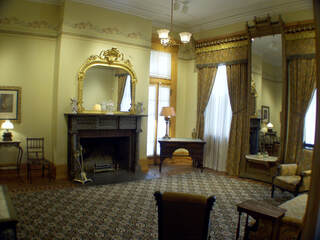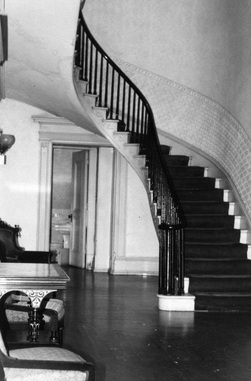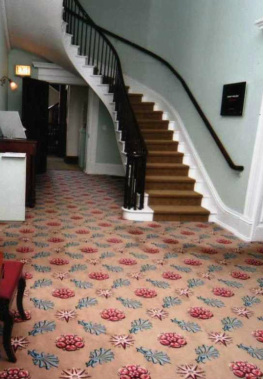History of the Reese-Peters House and Collections
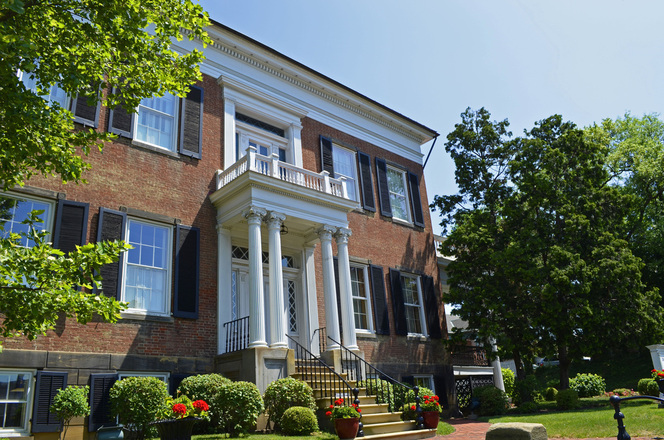
The Reese-Peters House was built in 1835 for William James Reese and his wife, Mary Elisabeth Sherman. Reese, a native of Philadelphia, was a well-educated man, graduating from the University of Pennsylvania’s law school in 1822. Mary Elisabeth was the eldest sister of General William T. Sherman and Senator John Sherman, who would both find fame later in the 19th century. The Reese’s mansion on “Main Hill” in the famous Square 13 was known from the beginning as the finest house in Lancaster.
In 1842, the Reeses left Lancaster in the aftermath of the economic panic of 1837. The house changed hands a number of times over the next 30 years, being held at one point by Darius Tallmadge, owner of the Ohio Stage Coach Company. In 1872, Philip and Caroline Rising purchased the house. Their grandson, Philip Rising Peters, was the last private owner. He died in 1954, leaving the Reese-Peters House in a trust, with the wish that it would someday be used for a civic purpose.
In 1994, the property was donated to the Fairfield County Commissioners by the Philip R. Peters Trust. In 1998, the Decorative Arts Center of Ohio, governed by a board of directors, was founded as a nonprofit, 501(C)(3) organization. The establishment of the Decorative Arts Center fulfilled the Peters family’s desire that the property be used for a civic purpose involving the arts.
Architecture
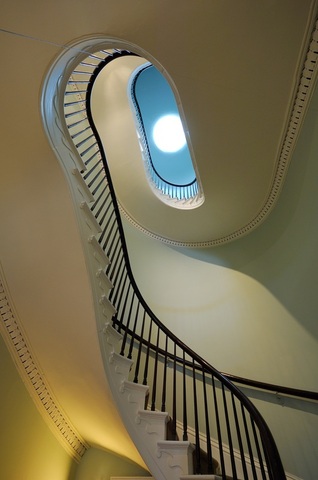
The Reese-Peters House is one of the great Federal/Greek Revival homes of Ohio. Although the architect is not known for certain, many believe that it was Daniel Sifford because some of the architectural features on the exterior of the Reese-Peters House match those on Sifford’s home, previously the American Legion Hall across Main Street.
In the first half of the 19th century, Grecian architecture was blooming in the East. Formed by the rediscovery of ancient Greece and the subsequent publication of its ancient monuments, architects like Benjamin Latrobe in Philadelphia, Alexander Jackson Davis in New York City and William Jay in Savannah, helped the Grecian movement become an American phenomenon, which eventually permeated the country as our first national architecture. Ohio settlers brought this nascent movement with them and many of the leading Grecian architects eventually settled in the new western states: William Strickland in Nashville, Francis Costigan in southern Indiana and Isaiah Rogers in Cincinnati. Others are recorded as building here: Minard Lafever, Thomas U. Walter, Davis and Latrobe. By the 1830s and 1840s, Ohio was an important workshop of Classicism. Talbot Hamlin, in his landmark book Greek Revival Architecture in America (Dover Publications, 1964) notes that in Ohio, "The result architecturally was a happy cross-fertilization, evident even in the early period. Inventiveness and novelty were as much a part of the picture as was traditional building."
In the first half of the 19th century, Grecian architecture was blooming in the East. Formed by the rediscovery of ancient Greece and the subsequent publication of its ancient monuments, architects like Benjamin Latrobe in Philadelphia, Alexander Jackson Davis in New York City and William Jay in Savannah, helped the Grecian movement become an American phenomenon, which eventually permeated the country as our first national architecture. Ohio settlers brought this nascent movement with them and many of the leading Grecian architects eventually settled in the new western states: William Strickland in Nashville, Francis Costigan in southern Indiana and Isaiah Rogers in Cincinnati. Others are recorded as building here: Minard Lafever, Thomas U. Walter, Davis and Latrobe. By the 1830s and 1840s, Ohio was an important workshop of Classicism. Talbot Hamlin, in his landmark book Greek Revival Architecture in America (Dover Publications, 1964) notes that in Ohio, "The result architecturally was a happy cross-fertilization, evident even in the early period. Inventiveness and novelty were as much a part of the picture as was traditional building."
Double Parlors During the Reese Era
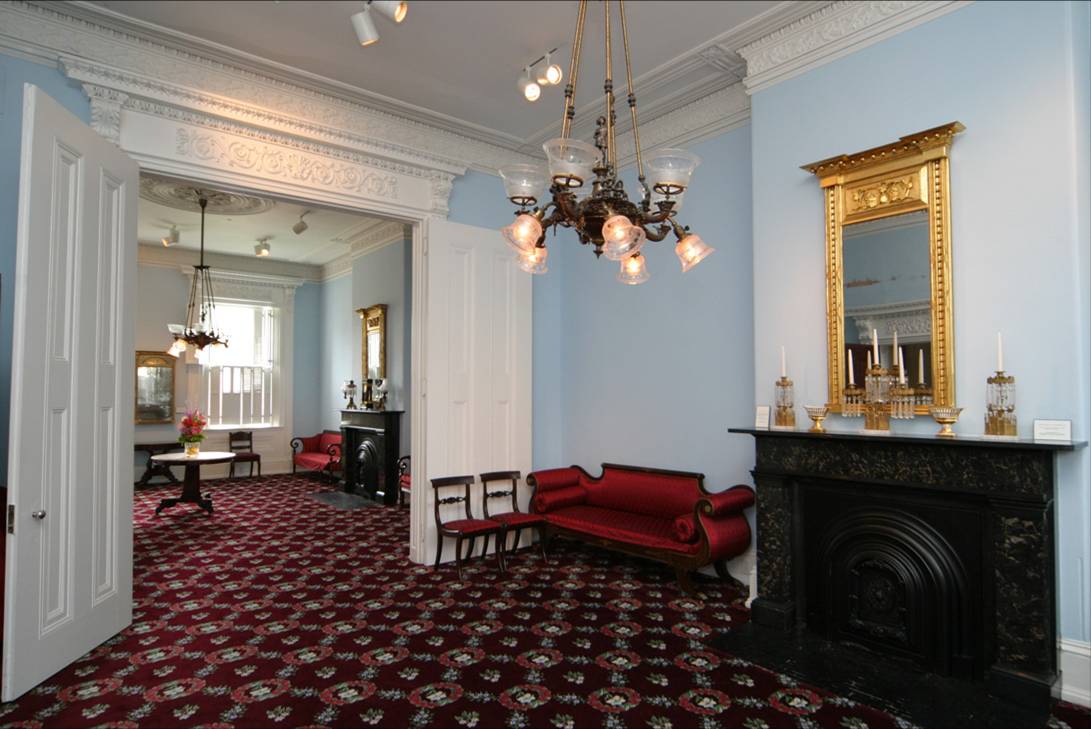
The time frame in which this house was built (1810-1850), is transitional. As a result the Reese-Peters House is an interesting model of a hybrid transition from Federal to Grecian architecture. The Reese-Peters House (1835), is based on the massing of Philadelphia Grecian townhouses yet has Federal motifs like the window lintels and a curious entry portico – exactly the portico by Benjamin that appeared in his pattern book The Practice of Architecture (1833). In this portico, composite columns, an elegant Roman addition, support the Corinthian entablature. Much of the interior detailing derives from plates in Lafever's Modern Builders Guide (1833), another popular reference for Ohio's Grecian builders. Benjamin's playfulness and Lafever's elegance, as delineated in these pattern books, elevated this house and much of Ohio architecture during the transition from Federal to Grecian.
Period Homes. January 2007. “Grecian Ohio.” William Heyer
|
To learn more about the history and architecture of the Reese-Peters House, check out our Around the House series.
Renovation
In the early 1990s a group of Lancaster citizens, led by Fairfield County Commissioner Lisa Kessler and working with the Peters family, began to formulate plans to develop the property as an arts facility. At the time of the gift to the Fairfield County Commissioners in 1995, the Ohio State Legislature, recognizing the potential of this site, allocated $1.2 million from the Capital Improvements Fund to help support the renovation of the Reese-Peters House as the Decorative Arts Center of Ohio, a nonprofit organization governed by a board of trustees. The renovation proceeded under the supervision of the Ohio Arts and Sports Facilities Commission, the County Commissioners, and the Decorative Arts Center board, and was designed by the architectural firm of Schooley Caldwell of Columbus. The general contractor was Durable Slate, also of Columbus. Renovation of the property, following careful research, was completed during the late 1990s with support from local and state funds and private contributions.
In September 2000, the Reese-Peters House and the Wendel Center for Art Education were dedicated as the Decorative Arts Center of Ohio.
In September 2000, the Reese-Peters House and the Wendel Center for Art Education were dedicated as the Decorative Arts Center of Ohio.

